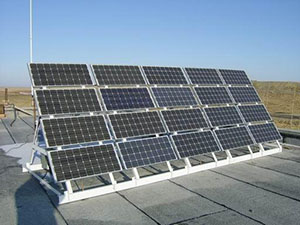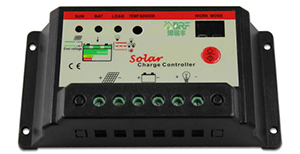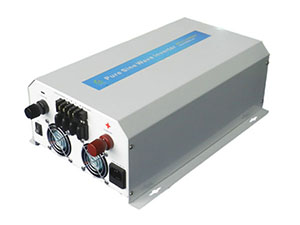CONTACT US
▪ Contact : Mr. Aiwah Tsou
▪ Mobile : + 86 189 2140 9789
▪ Tel. : + 86 (25) 8710 2206
▪ Fax : + 86 (25) 8710 2207
▪ E-mail : sales@ksunsolar.com
▪ Add.: 4-103, 18 Hubin Road,
Jiangning District, Nanjing,
China, 211106
The calculation principle of configuration for home solar power system is principle of conservation of energy, namely, the power that solar panel generates equal to consumption of total load and system wastage.
Process of Calculation:
1. To confirm how much power consumption for total load per day,
Q1=P*T,
Q1 is Power Consumption, unit is WH; P is power, unit is W; T is time, unit is H.
2. Estimate system wastage:
The usage rate of inverter is about 80% in small solar power system; The usage rate of inverter is about 90% in large solar power system. As the power wastage of solar controller is so small, here we ignore it. Therefore, solar panels need generate at least Q2=Q1/η, so that it can keep the balance. η is usage rate of inverter.
3. Calculate battery capacity:
The battery capacity is relative with backup time for usage. For lead-acid battery, it would be harm for its lifespan if discharging 100%, so we just discharge its 80% capacity. Moreover, as the battery is floating charge in later period to charge , it need keep 10% capacity to make better use of the power that solar panel generates (here need be confirmed according to power usage situation, if it is daytime to charge, then discharge in night, that need keep 10% battery capacity; If it is daytime to charge, discharge is also in daytime, that will no need to keep 10% capacity; namely, for the system which is charge in daytime and discharge in night, the depth of discharge is just 70% of full batter capacity; for those system that both of charge and discharge are in daytime, the depth of discharge can be up to 80% of full battery capacity. The efficient discharge of battery need meet the power usage for backup time.)
C*U*&=Q2*d, so, C=Q2*d/(V*&),
C is battery capacity, unit is Ah; U is system voltage, unit is V; & is efficient power discharge, usually it is 70% ~ 80%; d is days of backup; Q2 is power generation from solar panels, unit is WH.
4. How to calculate the power of solar panels ?
The power that solar panels generate not only need meet the power usage of load, it also need be enough to charge battery. Therefore, for those solar system with long time backup, need keep more power generation to meet its request. The battery allowance depends on the charging speed. According to power generation equals to power usage of load plus power charging into battery, P3*T2=Q2+Q3, P3 is power of solar panels, T2 is hours for efficient power generation a day, Q2 is power usage of load plus system wastage, Q3 is power charging into battery to keep battery allowance. Q3 rely on different situation, Q3 equal to its rated capacity multiply 1% ~ 3% of its rated voltage for those system which don’t have backup days. For those solar power system which have request for backup days, it can be calculated as about 20% of power that solar panels generate. For those area which is mainly sunlight in a year, Q3 can be reduced to 10%. For those area which is mainly rainy in a year, Q3 can be improved up to about 30%.
5. How to choose solar controller ?
In case to damage devices or power loss, the rated current of solar controller shouldn’t be less than the maximum output current of solar panel. The current of controller can be 120% of maximum output current of solar panel in those area where has strong sunlight; It can be decrease for those area where has weak sunlight.
6. How to configure solar inverter ?
Square wave inverter can be chosen for those solar system whose load is below 300W, because most of appliances which need sine wave are above 300W. It can be customized to configure according to customers’ requirement (Please note: Vehicle type square wave inverter can’t be used for those situation which is long term to use load).
Sine wave inverter mainly is chosen for those solar system whose load is above 600W, because the inductive load of most appliances, such as refrigerator, they need use the voltage which is sine wave. The power of inverter is calculated as 120% ~ 150% of system rated power. Its power can be adjusted according to customers’ request.
Take an Example for home solar power system,
One family in some area of Africa, the load and power usage are as below: 4pcs 30W LED bulbs, need light 6 hours each day; 1 set 100W desktop computer, work 8 hours each day; 1 set 500W refrigerator need consume power 0.8KWh/24h; 1 set 150W television, need work 5 hours average per day; Backup time is 3 days.
1. Calculate its power usage of load:
Power consumption of total load is Q1=4pcs*30W*6h+100W*8h+800KWh+150W*5h=3070WH; The maximum usage power P1=4pcs*30W+100W+500W+150W=870W. As it is AC load, we treat the usage rate of inverter as 80%, so the power usage of load: Q2=Q1/80%=3070WH/0.8=3837.5WH.
2. Calculate the battery capacity:
The total power consumption of backup for 3 days is Q2*3days=3837.5WH*3days=11512.5WH, take coefficient of efficient battery discharge as 0.76, voltage of battery is 12V. According to principle of conservation of energy, 11512.5WH=C*12V*0.76; C=11512.5WH/(12V*0.76)=1263AH. Considering solar panels also can generate some power under rainy days, so battery capacity can be as C=1200Ah, So, it can use 6pcs 200AH, 12V battery as 2 series connection and 3 parallel connects to compose 1200Ah, 24V battery.
3. Calculate the power of solar panels,
Take Africa as example, treat the efficient power generation from solar panels as 5 hours each day, request the battery need keep at least 90% of its capacity after usage within 10 days, so the solar panel need charge battery allowance Q3=11512.5WH/10days=1151.25WH, therefore, power generation of solar panel is Q2++Q3=3837.5WH+1151.25WH=4989WH, the power of solar panel is 4989WH/5H=998W, can use 4pcs 250W,18V solar panels.
4. How to choose solar controller ?
As system voltage is 24V, the maximum current output from solar panels is 1000W/24V=42A, so, we choose 42A, 24V solar controller.
5. How to choose inverter ?
As refrigerator belongs to inductive load and total load is 870W, so we can use 1000W, 24V pure sine wave inverter.
Therefore, this system, we choose 4pcs 250W solar panels, 6pcs 200AH, 12V batteries, 1pcs 42A, 24V solar controller and 1pcs 1000W, 24V solar inverter.
Copyright © 2014-2024 NANJING KSUNSOLAR TECHNOLOGY CO., LTD., All Rights Reserved.